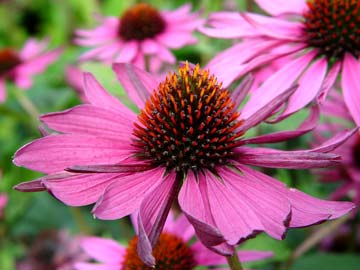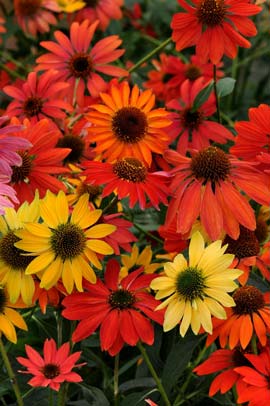 Classic purple coneflowers have pinkish-lavender flower petals that droop down around a central golden-brown cone.
Classic purple coneflowers have pinkish-lavender flower petals that droop down around a central golden-brown cone.
George Weigel
A popular goal of many home gardeners lately is to plant gardens that are attractive to birds, butterflies, bees and other pollinating insects.
Purple coneflowers fit that bill and have long blanketed sunny fields and meadows of eastern and central North America. They’re 2- to 3-foot-tall native perennial flowers recognized by their daisy-like flowers with drooping pinkish-lavender flower petals around a protruding, golden-brown central cone.
Purple coneflowers make durable, long-blooming and attractive flower displays in the garden. They bloom for weeks in mid to late summer and make good cut flowers, too.
 New introductions in coneflowers come in assorted colors and bloom shapes, such as this new variety called 'Cheyenne Spirit.'
New introductions in coneflowers come in assorted colors and bloom shapes, such as this new variety called 'Cheyenne Spirit.'
Photo by National Garden Bureau
Many new varieties are available that bloom in yellow, lime-white, red, rose and even orange in addition to the original pinkish-lavender. New dwarf options also are available that grow only 15 inches tall as well as types with double petals and petals that grow straight out instead of drooping down.
Growing Tips
- Plant them in full sun in well drained soil. Coneflowers don’t like soggy soil, especially in winter.
- Soak them during a prolonged drought, but otherwise, once the roots are established, coneflowers are some of the most heat- and drought-tough perennial flowers.
- Fertilize them in early spring, early summer and early fall.
- To encourage rebloom, snip off flower stems after the blooms fade. However, if you don’t mind possible reseeding and would rather feed the birds, let the flower heads alone so they produce mature seeds.
Cut frost-killed foliage to the ground at the end of winter. Clumps also can be dug, divided and replanted to “expand the flock” at that time.